GLBenchmark 2.5 Performance on Modern Android Smartphones & Tablets
by Anand Lal Shimpi & Brian Klug on July 31, 2012 10:00 AM EST- Posted in
- Smartphones
- GLBenchmark
- Mobile
- Tablets
- SoCs
For quite a while now, GLBenchmark has been a regular test in our smartphone, tablet, and SoC reviews. As GPU performance has steadily increased, GLbenchmark 2.1.x started hitting vsync more of the time in onscreen tests, necessitating an updated version of the test with heavier assests, reworked rendering code, and improved functionality for testing. Today Kishonti Informatics has released GLBenchmark 2.5.0 both on the Google Play store and to partners, and we're taking a first look at performance across the current crop of devices.
GLBenchmark 2.5.0 primarily addresses a few shortcomings from the previous version of the Egypt test, primarily by moving to a more challenging version of Egypt. The new game test is named Egypt HD, and moves to a much more complex scene while keeping roughly the same test animation. Geometry count has increased, texture resolution has increased, there's a new water shader, more reflections, and more shadowing. In addition, the offscreen test has now moved to a default resolution of 1080p instead of the previous 720p, for a more challenging workload. This offscreen resolution is now customizable, but we'll be running 1080p for ease of comparison. In addition, the "classic" Egypt test is also a part of GLBenchmark 2.5.0 for those wishing to compare to 2.1.5. In addition, the triangle and fill subtests also stay around for a lower level look at OpenGL ES 2.0 performance. It should go without saying, but GLBenchmark 2.5 is still an OpenGL ES 2.0 test.
We've run GLBenchmark 2.5.0 on all the devices we have on hand, and have split up the results between tablets and smartphones for ease of comparison. The iOS version of GLBenchmark 2.5.0 is still in the review process, and we'll be updating as soon as we can run that on our iPhone 4S, iPad 2, and iPad 3. For now however, we have a good look at performance for the latest devices in Android land.
Tablets
We have three major SoCs making up our tablet test candidates: NVIDIA's Tegra 3, NVIDIA's Tegra 2 and TI's OMAP 4430. When we get the iOS versions of GLBenchmark 2.5 we'll be able to add the A5 and A5X to this list. We're also waiting on our own Qualcomm MDP/T, which will let us add Adreno 320 results in a few weeks.
The fill and triangle rate tests show us just how far we've come since the days when Tegra 2 and the PowerVR SGX 540 were considered cream of the crop. NVIDIA's Tegra 3 is just significantly faster across the board. The Transformer Pad Infinity's added memory bandwidth (DDR3-1600) helps propel it above the other, lesser Tegra 3 configurations. Again there's nothing new here, just new data that validates what we've already known.
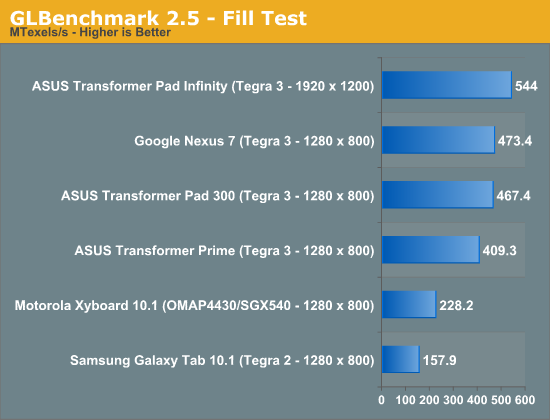
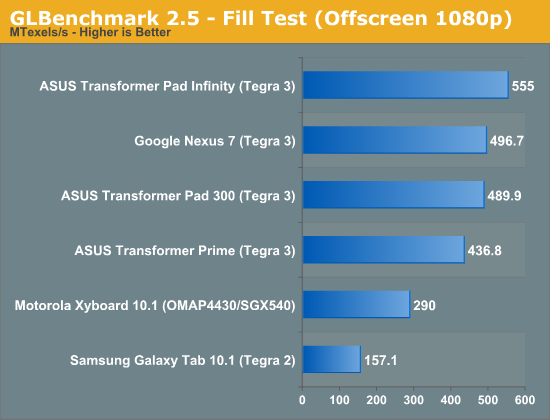
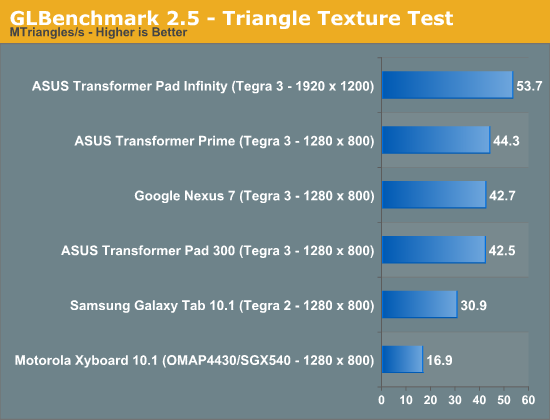
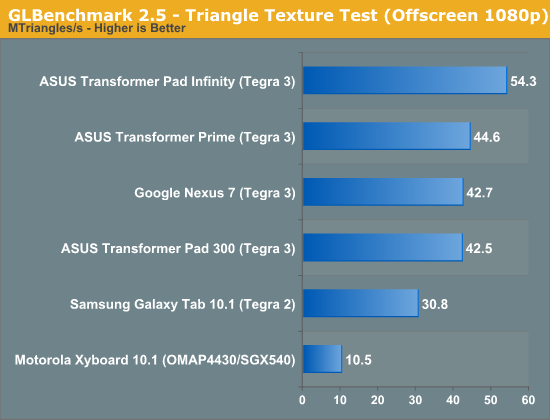
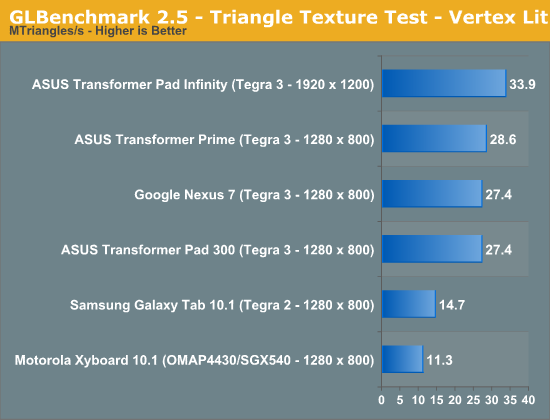
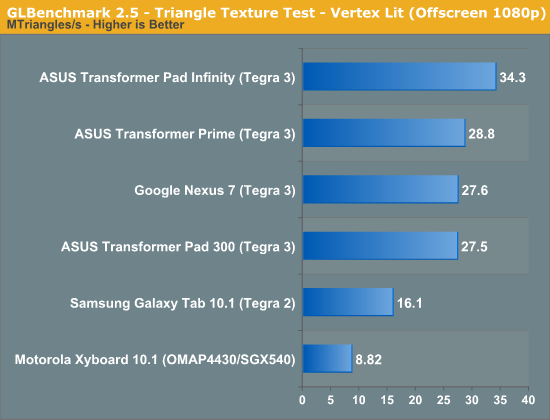


The Egypt HD test raises the bar for what is necessary to produce playable frame rates. At their native resolutions, none of these tablets can even deliver half of a playable 30 fps frame rate. For the next generation of games, we'll need performance around 3x better than NVIDIA's Tegra 3. Qualcomm's Adreno 320 has the ability to deliver that depending on the workload, so it's possible we may see > 30 fps results from it. The A5X should be able to break 30 fps as well, but we'll find out for sure in another day or so.
The offscreen results are even worse. Tegra 3 with DDR3-1600 is still only good for 11 fps. It shouldn't be any surprise, but we will need faster GPUs for better looking games. Egypt HD is definitely the new torture test for mobile SoCs.
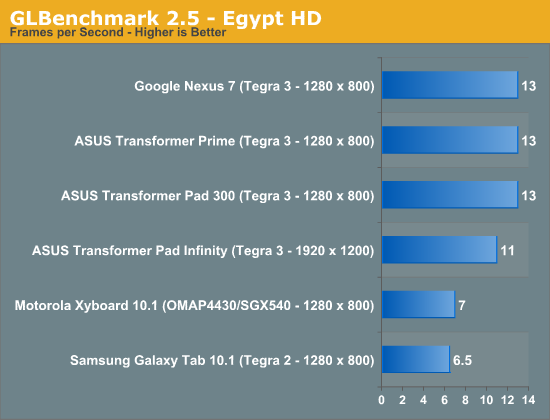
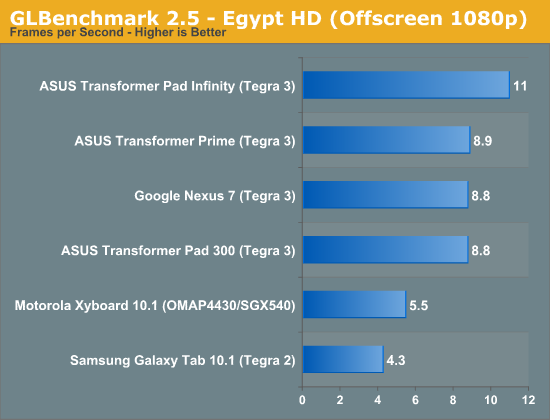
The Egypt Classic test ends up being Vsync limited on the 1280 x 800 Tegra 3 tablets, with even 1920 x 1200 running smoothly on the Transformer Pad Infinity. These numbers echo the reality of 3D gaming on Android today: pretty much everything runs well on Tegra 3.
The same can't be said for Tegra 2 or OMAP 4430 however, even at 1280 x 800 both of these SoCs deliver frame rates well below 30 fps.
The offscreen 1080p results paint a good picture for Tegra 3, which again can deliver average frame rates at or above 30 fps. Anything older than Tegra 3 however just can't pull it off.
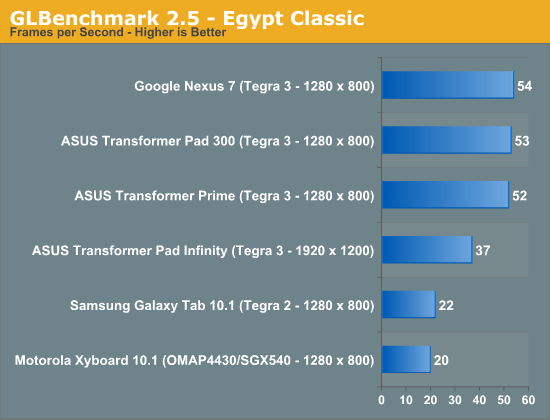



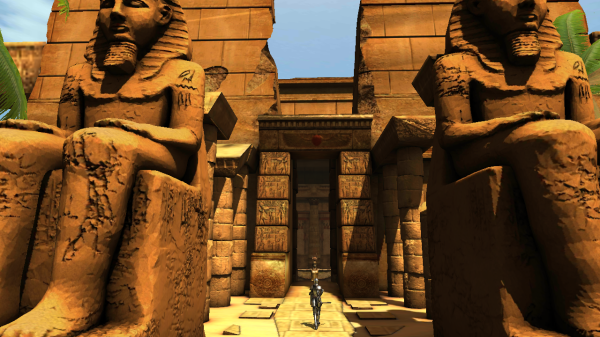














47 Comments
View All Comments
Mike1111 - Tuesday, July 31, 2012 - link
"A5X roughly triples the Fill Test of the Tegra 3. It also gets about 50 fps on the Offscreen test in Egypt HD."I wish. But I only see 24fps in the Egypt HD 1080p offscreen?!
pcinyourhand - Tuesday, July 31, 2012 - link
You clearly have no experience when it comes to GPU benchmarking..A GOOD benchmark is supposed to exercise the GPU heavily and stress the GPU and the SoC to accurately measure Graphics performance. A benchmark is not supposed to run at 30 or 60 fps...
metafor - Tuesday, July 31, 2012 - link
GLBenchmark 3.0 isn't just more stress. GPU's don't work like that. It's there to test the feature set of the Halti generation of GPU's, which aren't tested at all in GLB 2.5.The actual compute power stressed -- such as triangle throughput, fetch speed, fill-rate, etc. -- will likely stay the same between 3.0 and 2.5.
Pirks - Tuesday, July 31, 2012 - link
[vader]NOOOOOOOOOOOOOOOOOOOOOOOO!!!!!!!!!!!!!!!!!!!!!!!!!!!!!!!!!![/vader]aryonoco - Tuesday, July 31, 2012 - link
To truly make a fair comparison between SoCs, I think the version of Android should also be mentioned in the charts, as newer versions might come with newer/updated drivers which makes not so much of a level playing field.To illustrate the point, my Motorola (Droid) RAZR (OMAP 4430) gets 5.5 fps on Egypt HD onscreen test (running at qHD resolution). I find it interesting that it scores so much lower than the OMAP 4460 in the Galaxy Nexus, as they run on the exactly same clocks and until now, every GPU benchmark had put them exactly equal.
Which makes me wonder, what version of Android is the Galaxy Nexus running in this test? Is it Jelly Bean? Cause JB might come with newer drivers which might be adding to its performance (My RAZR is running ICS). The same might be true if you are comparing phones running ICS to those running Gingerbread.
balagamer - Wednesday, August 1, 2012 - link
will an optimized driver makes a difference in these scores? as the benchmark suite is just launched there is possibility that the current set of drivers for mali400 being unoptimized.SanX - Wednesday, August 8, 2012 - link
All these benchmarks, specifically for smartphones must be divided by consumed energy from the battery.Things are that 4-core processor consume much more juice from the battery on such gaming tests!!!!